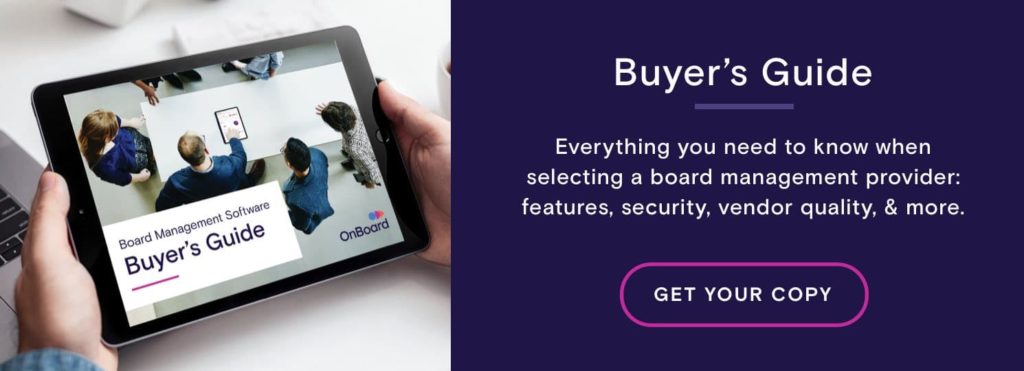
Today, many community banks use outdated technology and processes in the boardroom, which can prevent these local financial institutions from reaching their full potential.
According to the Independent Community Bankers of America (ICBA), there are more than 50,000 community bank locations throughout the U.S. Each one plays an important role in its local economy.
Unlike national banks such as Chase Bank, Wells Fargo and Bank of America, community banks are typically locally owned and operated. They know and understand the needs of the communities they serve — and they’re dedicated to helping them thrive.
Community banks typically take a more local, personalized approach to banking and lending. Money is kept within the community. Plus, the relationship with customers feels more personal, and many customers form lifelong relationships with their local banker.
It seems consumers appreciate this hands-on approach. A survey from the Federal Reserve found that 79% of respondents were happy with their small-bank lender, compared to 67% who were satisfied with their larger bank.
While it’s true that community banks differ from larger institutions in some ways, there are also plenty of similarities in the ways they operate.
Large and small banks alike rely on the leadership of a board of directors, and they have similar requirements for their boards and board management. What’s more, banks of all sizes must adhere to certain regulatory and compliance requirements.
Now is the time for community banks to move toward digital-first board management by adopting the right board portal.
Digital Transformation for Community Banks
Community banks work hard to deliver the digital tools and technologies that customers have come to expect from larger institutions. But all too often, the same level of digital transformation simply isn’t a reality in the boardroom.
Community bank boards often use outdated technology and employ inefficient, unnecessarily lengthy processes and procedures — many of which are paper-based. As a result, board meeting preparation requires too much time and resources.
Over the course of a year, that time adds up. In fact, each year, the team at First National Bank Texas spent about 540 hours (or, approximately 67.5 working days!) compiling, proofreading, and printing pages for board meetings. That doesn’t even include the exorbitant printing costs.
What’s more, because it takes so long to compile board meeting materials, they’re often not available until the meeting occurs. As a result, a large portion of the board meeting is spent reviewing materials, rather than making decisions and taking action.
However, a growing number of community banks are moving away from traditional, paper-based board management methods and instead opting to adopt a digital board portal such as OnBoard, the only board portal endorsed by the Independent Community Bankers of America, as well as the Texas Bankers Association.
The right board portal can help community banks streamline key board processes and procedures, saving time and money. Case in point? By partnering with OnBoard, First National Bank Texas has significantly reduced the amount of time spent creating meeting materials, and saved more than $85,000 in annual paper and printing costs.
What’s more, the most up-to-date board books and other key materials are available to board members in real time from a single, secure digital location. That means board members can review materials in advanc, and come to meetings prepared to take action that’ll move the community bank closer to its goals.
Boardroom Security: A Must for Community Banks
Community banks are entrusted with sensitive financial information. Sometimes, board members require access to this information in order to serve in their various committee roles.
Community banks must ensure its data doesn’t get into the wrong hands. Even a single slip-up can result in some hefty consequences. A community bank can incur costly legal trouble — and lose the trust it’s worked hard to build within the community.
Paper-based operations put an organization at risk of the wrong information getting into the wrong hands. A document distributed during a board meeting can easily be misplaced. Or one sent via mail for an upcoming, virtual board meeting could be lost in transit. Even information sent electronically via email attachments or a service like Google Drive or DropBox isn’t as secure as one might hope.
On the other hand, a secure board portal provides board members with easy access to the information they need, while ensuring sensitive data is always safe and sound. For example, OnBoard is built on Microsoft Azure, which is compliant with the strictest standards in the industry. What’s more, OnBoard has been awarded SOC 2 and ISO 27001 certificates, so community banks can rest easy knowing their information is secure and compliant.
Improving the Effectiveness of Boards' Committees
Community bank boards are often composed of different committees, including loan approval, supervisory, IT/steering, and audit, among others. Oftentimes, the processes of these myriad committees are inefficient, which stands in the way of progress.
For example, loan activity is a key way community banks generate revenue. But oftentimes, the approval process is unnecessarily long and bogged down with manual, cumbersome processes. Sturgis Bank & Trust Company typically processes around 100 loan applications each week. Prior to partnering with OnBoard, each loan required physical signatures on a paper contract. Loan officers would walk around the office to get signatures from bank officials. If some officials weren’t available, it tied up the loan process.
Over time, inefficient loan processes like this can have a large, negative impact on a bank’s ability to generate revenue. As such, community banks must make it a priority to streamline and aim for a faster loan approval process. A board portal is essential to process improvement.
A board portal like OnBoard streamlines and expedites the entire loan approval process. A loan approval gets uploaded, and then the entire team gets notified in real time. Team members can discuss the loan within OnBoard, and officers can vote anytime, anywhere — rather than waiting for the next board meeting.
It's Time to Partner with the Right Board Portal
Board members play an important role in the operations of community banks. But oftentimes, the boardroom is rife with inefficiencies, which stands in the way of this group achieving more for the community banks they serve.
Now’s the time to move toward digital-first board management by using a board portal like OnBoard. Doing so will improve the effectiveness and efficiency of board members while preserving security and compliance.
Ready to take your meeting agenda and minutes to the next level? Request a demo or a free trial of OnBoard, the board intelligence platform that empowers boards and committees to hold more effective, informed, and uncomplicated meetings.
About The Author

- OnBoard Meetings
- At OnBoard, we believe board meetings should be informed, effective, and uncomplicated. That’s why we give boards and leadership teams an elegant solution that simplifies governance. With customers in higher education, nonprofit, health care systems, government, and corporate enterprise business, OnBoard is the leading board management provider.
Latest entries
 Board Management SoftwareJuly 26, 20225 Critical Board Engagement Survey Questions
Board Management SoftwareJuly 26, 20225 Critical Board Engagement Survey Questions Board Management SoftwareJuly 19, 2022What is an Advisory Council? (Overview, Roles, and Responsibilities)
Board Management SoftwareJuly 19, 2022What is an Advisory Council? (Overview, Roles, and Responsibilities) Board Management SoftwareJuly 15, 2022Balance Sheet vs. Income Statement: What’s the Difference?
Board Management SoftwareJuly 15, 2022Balance Sheet vs. Income Statement: What’s the Difference? Board Management SoftwareJuly 12, 2022Sweat Equity: Mark Haas of the Dallas Cup Board Gives a Nonprofit Play-by-Play for Success
Board Management SoftwareJuly 12, 2022Sweat Equity: Mark Haas of the Dallas Cup Board Gives a Nonprofit Play-by-Play for Success


